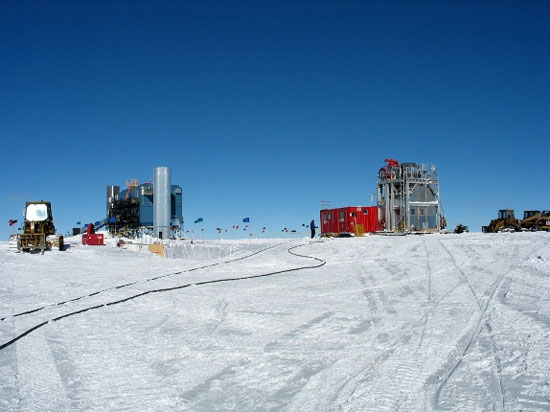Strange findings under the ice layer of Antarctica
For the first time since 26 years, scientists have discovered high - energy neutrinos - that is the fundamental particle that can become 'the key' to solving many problems in the field of space research.
>>>The neutrinos move faster than the speed of light
Particularly strange detection
The discovery was made by a group of American scientists. They used the IceCube telescope buried deep in Antarctic ice for their research work. This telescope consists of 5160 optical modules, which are used to detect light emitted by the Antarctic ice when neutrinos hit. By chance, the scientists discovered traces of high-energy neutrinos (which they called Bert and Ernie, after the names of two characters in the US television show "Ginger Street". ) while searching for signals from low energy neutrinos, produced in the earth's atmosphere.
Earlier, in 1987, underground neutrino detectors also detected 3 neutrino particles that seemed to come from the Magellan Clouds . Over the next 26 years, scientists also failed to detect any more neutrino particles originating from the solar system.

Researchers believe that neutrino Bert and Ernie represent the neutrinos that fly to Earth from the distant universe. The probability to catch them is 1/370. 'It is a particularly strange finding, starting with astronomy based on high-energy particle research , ' said John Learned of the University of Hawaii.
High-energy neutrinos are less likely to form in the earth's atmosphere. Even if this were to happen, it would not overshadow the success of scientists, because until now, researches based on the IceCube telescope did not detect such high-energy neutrinos in the atmosphere. .
Now, scientists are trying to find convincing evidence to prove that newly discovered high-energy neutrinos have originated from outer space.
What do we look for neutrinos for?
Neutrinos are fundamental particles, always a mystery to scientists. They have no charge. Their mass is negligible. Thus neutrinos can move in the universe without obstacles. Neutrinos can pass through matter; their orbits are not bent by the magnetic fields of bodies in the universe (unlike the case of electrons).
These characteristics on the one hand interfere with the work of scientists, because they make detection and therefore the study of neutrinos very difficult. On the other hand, high energy neutrinos can help scientists analyze the explosion of supernovae.
Since we cannot bring the space probe close to such explosions, the only possibility to study them is to find radiation formed during the phenomenon of supernova explosions. Unfortunately, before reaching Earth, the radiation beams are curved or absorbed by the planets and stars.
However, in addition to radiation, supernovae also send neutrinos into space. Because neutrinos are not influenced by celestial bodies they pass by, so if we study neutrinos, then we will get lots of valuable information about the exploding stars.
Not only supernovae create neutrinos. In many objects in the universe, reactions that produce these particles, such as the sun, can occur. That means the ability to capture neutrinos flying to Earth allows us to study more remote areas in the universe more accurately.
- New discovery of the ozone layer gap in Antarctica
- Still need to be alert for ozone layer hole
- The person who discovered the ozone layer hole died
- Ozone layer recovered: Happy or worried?
- Ozone holes in Antarctica show signs of shrinking
- The ozone layer gap in Antarctica begins to shrink
- Why is the ozone hole concentrated in Antarctica?
- The ozone layer has started to recover?
- The area of ice in Antarctica is mysteriously narrow
- Deciphering the blood waterfall 'mystery in Antarctica
- The Earth's ozone layer is being filled again
- What is the ozone layer?
 'Fine laughs' - Scary and painful torture in ancient times
'Fine laughs' - Scary and painful torture in ancient times The sequence of numbers 142857 of the Egyptian pyramids is known as the strangest number in the world - Why?
The sequence of numbers 142857 of the Egyptian pyramids is known as the strangest number in the world - Why? History of the iron
History of the iron What is alum?
What is alum?